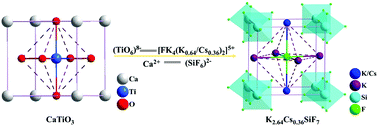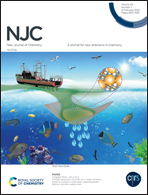K2.64Cs0.36SiF7: a new fluorosilicate with a trans-perovskite structure†
Abstract
A new oxygen-free fluorosilicate, namely K2.64Cs0.36SiF7 was synthesized via a high-temperature method. It crystallizes in a tetragonal system with the P4/mbm space group. The cell parameters of K2.64Cs0.36SiF7 are found to be a = 7.768(4) Å and c = 5.560(6) Å. Single crystal X-ray diffraction shows that it has a trans-perovskite structure built by the [SiF6] and [FK4(K0.64/Cs0.36)2] octahedra. By a structural analysis, the disorder place and the disorder ratio of K2.64Cs0.36SiF7 is different from other M3SiF7 (M = K+, Rb+, Cs+, and NH4+) compounds. The ultraviolet cut-off edge of K2.64Cs0.36SiF7 is shorter than 190 nm, and the band gap is 6.0 eV. Structure–property relationships were further illuminated via the first-principles calculation methods.



 Please wait while we load your content...
Please wait while we load your content...